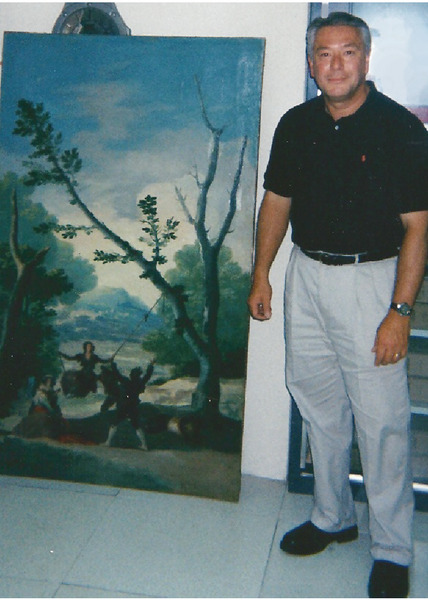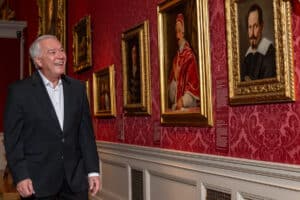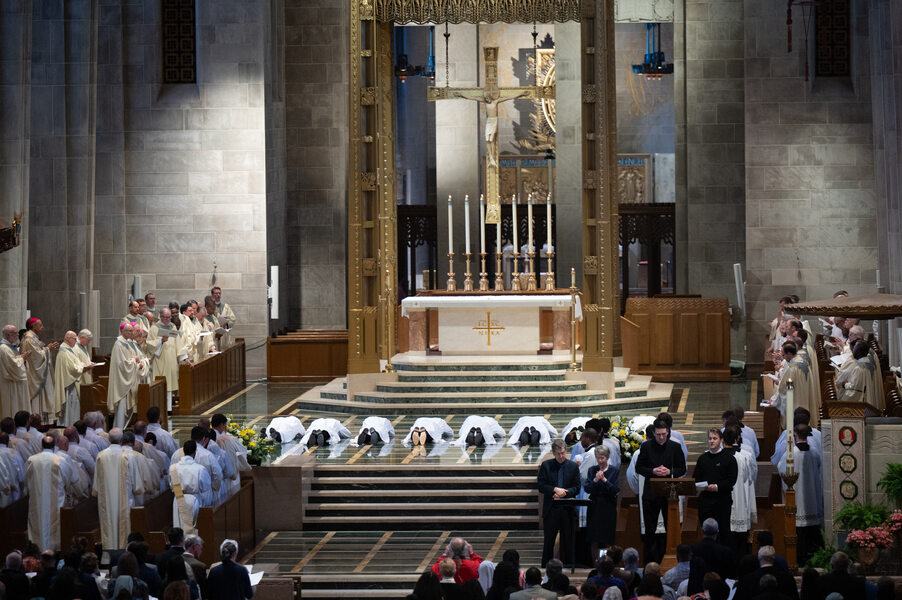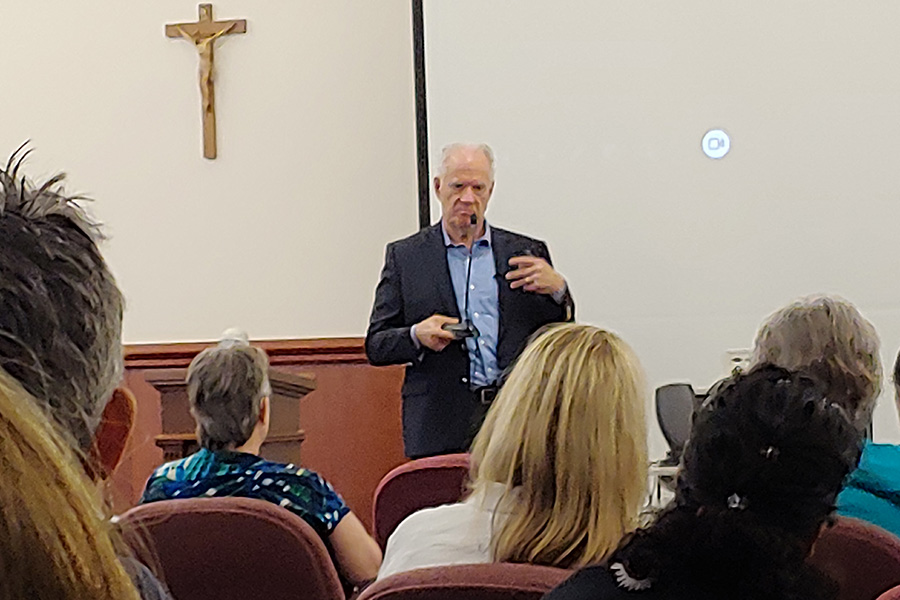Robert Wittman, founder of the FBI Art Crime Team and a special agent for 20 years, described his recent attendance at the Calvert Hall High School College 50-year reunion as “sickening.”
It was not an indictment, but rather a good-humored, ironic summation of the surprising amount of time that had elapsed and the can’t-make-this-stuff-up life trajectory that had unfolded over those five decades.
Wittman, who grew up in Baltimore’s Hamilton neighborhood and received the sacraments at nearby St. Dominic Church and his grade school education at the former parish school, has recovered countless artifacts and pieces of art, including works by Rembrandt, Goya, Manet and Rodin. He returned a piece of golden armor that had belonged to a king from Peru’s ancient Moche civilization, Geronimo’s headdress, and the battle flag of the Twelfth Regiment Infantry, the Corps d’Afrique, from the Civil War.

Formative years
Wittman called his Calvert Hall education “great.”
“It played a major part in forming my moral and ethical outlook on life,” he said.
His parents and his Baltimore upbringing were also pivotal. Wittman’s father, Robert A. Wittman, and mother, Yachiyo Akaishi Wittman, met when the former was stationed in Japan with the U.S. Air Force during the Korean War. The family moved to Baltimore in 1957, when the younger Wittman was 2.
“Coming over with a Japanese mother, there was a certain amount of prejudice,” Wittman said, noting that World War II was at that time in the not-too-distant past.
It was, in part, a 1960s TV series – “The F.B.I.,” starring Efram Zimbalist Jr., as Inspector Lewis Erskine – that brought the federal law enforcement agency to Wittman’s attention.
“I thought, ‘They’re the protectors of civil rights, and I would like to be a part of that,’ ” he recalled.
He also had a neighbor across the street, Walter Gordon, who was a special agent.
“He was a good guy,” Wittman said, using a simple but fitting expression applicable to both Gordon’s kind, responsible demeanor and his life’s work in direct opposition to “the bad guys.”
The work Wittman did for his father’s varied businesses also influenced Wittman’s future career. He sold advertising for the string of agriculture industry newspapers that his father later acquired and also spent time helping the elder Wittman at his Howard Street antique store, amid Jeweler’s Row, which specialized in Asian art and artifacts.
That job, of course, contributed to Wittman’s practical knowledge of art and the business around it, and the publishing job gave him valuable experience in selling himself – experience he would put to good use from 1996 to 2008, during which he was typically “undercover in some part of the world” while in pursuit of stolen art.
The ins and outs of art theft
Wittman, married with three grown children and some grandchildren, told the Review that the value of a work of art is dependent on three variables: the piece’s authenticity, its history and a “good title.” Because thieves do not have the third, they will find themselves in a genuine conundrum once the thievery part has been accomplished, he said.

“They are better criminals than they are businessmen,” Wittman explained wryly, recalling one incident in which he found himself in a Danish hotel room, counting out cash in an exchange for Rembrandt’s “Self-Portrait,” (see photos at left).
Wittman noted that art theft can be brazen, as in the above example, but most of the time it is committed by someone with an inside connection to a museum – a janitor or curator, for example.
Wittman’s New York Times bestseller, “Priceless: How I Went Undercover to Rescue the World’s Stolen Treasures,” recalls a night watchman who systematically stole 145 pieces from Baltimore’s Walters Art Museum, “taking the pieces one by one over eight months – each night, while making his rounds, he pried open a display case, pinched an Asian artifact or two, then rearranged the rest of the pieces so the display wouldn’t look suspicious.”
The thefts occurred in the late 1980s. A Washington Post article at the time noted that the museum considered the incident more an egregious breach of trust – the watchman had been employed with the museum for a relatively long time – than a security system failure. The motive was unclear, but the thief did melt down some golden objects, which suggests that he was not likely after art for art’s sake.
Some thieves are, though.
“Some people will steal it for themselves,” Wittman explained, especially when it comes to items stored in a museum’s archive rather than on display.
A twisted yet understandable logic will “justify” such acts, he noted: “I really like it, and I understand it, and the people at the museum aren’t even exhibiting it. Therefore, I have the right to have it.”
The Greater Good
While Wittman enjoyed administering justice, it was the art itself – or, more specifically, the art’s connection to humanity – that truly motivated him.
In his book, he ascribed that motivation to his father. In their last conversation, Wittman wrote, he had told his dad about a burglary at the historical home of William Penn, founder of Philadelphia. He mentioned a few suspects, but the 68-year-old, ailing elder Wittman interrupted him:
“Don’t tell me about the suspects. What about the antiques they took? Are you going to be able to get them back?”
“That was Dad,” Wittman wrote. “He understood what was important – retrieving stolen pieces of history and culture, not arresting a couple of knuckleheads trying to pawn a few pieces of silver.”
He recalled a Washington ceremony – described in his book – in which the FBI returned the Twelfth Regiment Infantry flag, which Black soldiers from Louisiana had carried as they contributed to the Union’s attack on Port Hudson, a pivotal battle in the Civil War.
Joseph Lee, then the leader of a Philadelphia-area reenactor’s group, described touching the recovered flag:
“Touching that flag sent chills through my body. Even thinking about it now, tears well in my eyes. They cause my heart to palpitate. Because this was true, living African American history.”
Wittman, who lives in Philadelphia, is now retired from the FBI, but he runs Robert Wittman Inc., a firm that specializes in art security.
He looks back on his career with gratitude, and it all began with him answering an ad in the Catonsville Times at 31.
“I never looked back,” Wittman said. “It was a great career.”
National Treasure
Robert Wittman’s most valuable recovery in an undercover operation was one of the original hand-written editions of the U.S. Bill of Rights sent to North Carolina in 1789 for ratification. Stolen in 1865 from the state house in Raleigh, N.C., by a Union Army trooper, it was being offered for sale to the National Constitution Center in Philadelphia for $4 million. Wittman posed as a wealthy philanthropist donating the money. If it could be sold, it has been estimated that it would be worth $100 million.
Read More Local News
Copyright © 2024 Catholic Review Media







